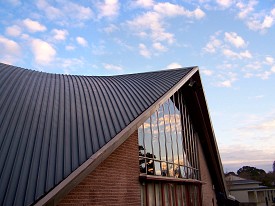Keep the Roof Over Your Head in Good Shape for Longer
 "A roof over one's head" is a synonym for home. And no wonder ... your roof faithfully performs the essential task of shielding your family and your belongings from the elements. Return the favor by taking good care of this essential part of your house. These simple tips will help extend its useful life.
"A roof over one's head" is a synonym for home. And no wonder ... your roof faithfully performs the essential task of shielding your family and your belongings from the elements. Return the favor by taking good care of this essential part of your house. These simple tips will help extend its useful life.
Maintain Your Roof
Don't allow leaves or snow to accumulate on your roof. (Clear out gutters regularly too!) Leaves will trap moisture from dew and rain, holding it against the roof where it can do damage. Snow will melt and refreeze, causing ice dams. In addition, the sheer weight of a winter's worth of snow may be more than your roof was designed to handle.
Trim any overhanging tree limbs so they're no less than 10 feet from your roof. Not only will this prevent leaves falling onto the house, it also safeguards against branches scraping the roof during a storm. Exposing the roof to sunlight deters the growth of moss and mold, as well. Last but not least, this measure blocks easy access to your roof by squirrels and other animal pests.
Avoid walking on the roof to inspect or clean it. This can be dangerous for both your roof and yourself. Standing solidly on the ground, use a dedicated non-metal roof rake to pull off fresh snow or fallen leaves. Spray with a garden hose to remove moss or algae buildup in summer. Avoid pressure washing, which has tremendous destructive potential when unleashed on your roof; the powerful stream can loosen roofing tabs, unglue the shingles' self-adhesive, and wash off the reflective granules.
Schedule a professional roof inspection regularly every 2-3 years, as well as after any severe weather event such as a hailstorm or gale-force winds.
Ventilate the Attic
During the winter, homeowners tend to keep their houses closed up. This allows warm moist air -- from showering, cooking, or running appliances like humidifiers -- to collect in your attic if it is not adequately ventilated. And guess what is sitting right on top of your attic? Hello! The underside of your roof.
The situation is no better in summertime when an insufficiently ventilated attic can play host to air at temperatures as high as 160 degrees. This kind of heat is very, very bad news for your roof rafters and asphalt shingles.
Don't despair, though. If you have properly functioning air intake vents combined with exhaust ventilation in your attic, excessive heat and moisture will be directed where you want them, outside the house.
Watch Out for Roofing's Red Flags
Stay alert. Loose, buckled, or missing shingles need to be taken care of ASAP, as they are an open invitation for moisture to penetrate your roof. If you tackle the problem early enough, you may need to replace only the affected shingles, instead of paying for a whole new roof.
Damp or peeling patches on your attic ceiling, dripping water, or light shining through are obvious signs that your roof is in big trouble. However, those are not the only red flags to watch out for. Exposed roof beams or doors and windows that are suddenly hard to open may also be signaling that excess moisture is getting into your house, most likely via the roof. All of these symptoms are another indication that it's time to call in a roofing contractor.
Recognize when it's Time to Replace
All good things eventually come to an end, and your roofing material is no exception. After a certain point, it makes more sense to replace, rather than to repair, the roof, namely when one or more of these is true:
- At least 30 percent of the roofing has become damaged over time.
- The supporting structure is seriously rotted.
- A natural disaster (for example, a hurricane) has taken a heavy toll on your roof.
- The roof's near the end of its normal lifespan -- 25 years for asphalt shingles, 35 for hardwood shakes, 45 for high-end shingles, 80 for clay tiles, or 100 for slate. After this point, repairing the roof rather than installing a replacement no longer makes financial sense.
Laura Firszt writes for networx.com.
Updated August 26, 2018.
Looking for a Pro? Call us (866) 441-6648

Roofing Average Costs
Roofers Experiences

Roof Replacement BEFORE It Started To Leak

Partial Siding Replacement To Get Rid Of Dry Rot



